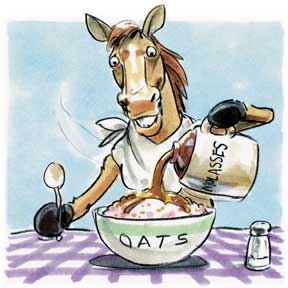|
content to about 40 percent, you will quickly realize that there is far less
sugar in the offending molasses than was first believed. Additionally, the
horse feed really only uses about 10 percent of molasses, and with a few short
clicks on the calculator you will be able to calculate that the actual amount
of sugar your horse may be exposed to per pound of feed is about four percent.
Compare this figure to the 12 percent sugar usually contained in alfalfa hay,
and it becomes quite apparent that the molasses added to the feed does not
really add that much sugar to the horse’s daily intake.
Yet what is the cause for the aforementioned ailments and behavior problems
experienced by horses and horse owners? One possible explanation may lay in the
fact that the horse is ingesting too many calories while not receiving
sufficient exercise to burn off the extra energy. Hyperactivity has also been
blamed on the fact feed is supplemented with more grain than hay, thus adding
extreme capacity to the amount of energy the horse is taking in. As a horse
owner, you will be able to quickly and concisely correct your horse’s energy
intake by supplying a feed with an elevated fat content. Thus, the density of
the consumed energy will be higher, whereas the amount of feed required will be
lowered. This will permit you to decrease the amount of grain fed, resulting in
a possible prevention of hyperactivity as well as reduced blood glucose levels
and therefore lesser chances of diabetes. Keep in mind, however, that raising
the percentage of fat too dramatically will lead to an actual elevation of
blood glucose!

For those who are still not quite convinced about the molasses in their horse’s
feed, consider the calculation of non-structural carbohydrates (NSC) that are
contained in the feed. Behind the moniker hide the kinds of carbs that are made
up of starches and sugars that are being digested in the horse’s gut via
enzymatic actions. Scientists have discovered that timothy hay contains the
lowest levels of NSC. Furthermore, those horse feeds that are rich in fiber as
well as fat will have a lower NSC number than those that lack fat and fiber. Of
course, if your horse is susceptible to colic and also founder, or if your
horse did receive the diagnosis of Equine Cushing’s disease, you will want to
pay special attention to the ingredient listing of the feed and search for the
kind of feed that offers a low level of NSC. In addition to the foregoing, you
will want to offer high quality grass hay to your animal to further decrease
the NSC levels in the animal’s diet.
 |